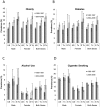Incidence and risk factors for hepatocellular carcinoma in Texas Latinos: implications for prevention research
- PMID: 22530052
- PMCID: PMC3329468
- DOI: 10.1371/journal.pone.0035573
Incidence and risk factors for hepatocellular carcinoma in Texas Latinos: implications for prevention research
Abstract
Background: Hepatocellular carcinoma (HCC) is increasing in the U.S. despite a decline in cancer overall. Latinos have higher rates of HCC than the general population according to the Surveillance, Epidemiology, and End Results (SEER) Program. Not included in SEER, Texas Latinos make up one-fifth of the U.S. Latino population. To determine whether HCC incidence differs among U.S. and Texas Latinos, this descriptive study compares HCC incidence from 1995 through 2006 among three Latino populations: U.S. SEER, Texas overall and a South Texas subset. To identify lines of prevention research, we compare prevalence of known HCC risk factors among these Latino groups.
Methods: Data were collected from the U.S. SEER Program, Texas Cancer Registry and Texas Department of State Health Services (TDSHS). Annual age-specific and age-adjusted HCC incidence rates, annual percent changes (APCs) and 95% confidence intervals were calculated as well as prevalence of obesity, diabetes, heavy alcohol use and cigarette smoking.
Results: Of the three Latino groups compared, South Texas Latinos had the highest age-adjusted HCC incidence rates and SEER Latinos had the lowest (10.6/100,000 (10.1-11.1) and 7.5/100,000 (7.2-7.7), respectively). HCC incidence significantly increased over time (APCs>0) among Latinos in all three geographic groups. Between 1995 and 2006, there was an increase in obesity among all three populations, and obesity was highest among South Texas Latinos. Diabetes increased among U.S. Latinos, and Latino women in South Texas had significantly higher diabetes prevalence than U.S. Latino women. Cigarette smoking and heavy alcohol use were similar among groups.
Conclusions: The incidence of HCC among Latinos in South Texas is higher than elsewhere in the United States. Higher rates of HCC among Texas and South Texas Latinos may be associated with greater prevalence of obesity and diabetes, risk factors for HCC that are amenable to intervention.
Conflict of interest statement
Figures



References
-
- Ferlay J, Shin HR, Bray F, Forman D, Mathers C, et al. GLOBOCAN 2008, Cancer Incidence and Mortality Worldwide: No. 10. Lyon, France: International Agency for Research on Cancer; 2010. [online] http://globocan.iarc.fr.
-
- Caldwell S, Crespo D, Kang H, Al-Osaimi A. Obesity and hepatocellular carcinoma. Gastroenterology. 2004;127:S97–S103. - PubMed
-
- Morgan T, Mandayam S, Jamal M. Alcohol and hepatocellular carcinoma. Gastroenterology. 2004;127:S87–S96. - PubMed
-
- Barazani Y, Hiatt J, Tong M, Busuttil R. Chronic viral hepatitis and hepatocellular carcinoma. World journal of surgery. 2007;31:1245–1250. - PubMed
Publication types
MeSH terms
Grants and funding
LinkOut - more resources
Full Text Sources
Medical
Miscellaneous

